

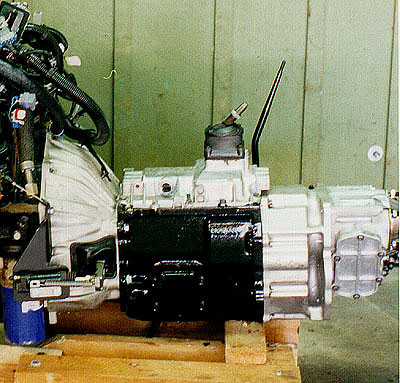 In
1992, General Motors and Dodge began equipping their trucks with a new
heavy-duty, 5-speed manual transmission known as the New Venture 4500,
or simply NV4500. This is a 5-speed, constant mesh transmission with
all forward gears fully synchronized (Dodge models even offer a synchronized
reverse gear, and that can be added to the GM versions). It is a
large and extremely sturdy transmission constructed with a cast iron case
and aluminum alloy top. It weighs in at just under 200 lbs (dry) and was
designed with the strength necessary for one-ton truck applications with
a GVW rating of 14,500 lbs. The 5th
gear is an overdrive with a gear ratio of 0.73:1. Immediately
upon its introduction, this transmission was recognized by off-road enthusiasts
to be an ideal transmission for conversions. In addition to its strength
and overdrive gear, it offered an ultra-low first gear ratio of 6.34.
Unfortunately, the ultra-low 1st
gear was discontinued in 1995 and replaced with a higher, but still-impressive
1st gear ratio of
5.61. To put these gear ratios in perspective the stock TLC 4-speed
has a 1st gear
ratio of 4.9:1. The early, low-gear-ratio transmissions
are obviously in high demand and with low supply (need I say expensive).
In
1992, General Motors and Dodge began equipping their trucks with a new
heavy-duty, 5-speed manual transmission known as the New Venture 4500,
or simply NV4500. This is a 5-speed, constant mesh transmission with
all forward gears fully synchronized (Dodge models even offer a synchronized
reverse gear, and that can be added to the GM versions). It is a
large and extremely sturdy transmission constructed with a cast iron case
and aluminum alloy top. It weighs in at just under 200 lbs (dry) and was
designed with the strength necessary for one-ton truck applications with
a GVW rating of 14,500 lbs. The 5th
gear is an overdrive with a gear ratio of 0.73:1. Immediately
upon its introduction, this transmission was recognized by off-road enthusiasts
to be an ideal transmission for conversions. In addition to its strength
and overdrive gear, it offered an ultra-low first gear ratio of 6.34.
Unfortunately, the ultra-low 1st
gear was discontinued in 1995 and replaced with a higher, but still-impressive
1st gear ratio of
5.61. To put these gear ratios in perspective the stock TLC 4-speed
has a 1st gear
ratio of 4.9:1. The early, low-gear-ratio transmissions
are obviously in high demand and with low supply (need I say expensive).
In weighing the options, availability and cost, we chose to purchase a 1995 model from a salvage yard. It came from a 3/4 ton Chevy 4WD that was rolled and totaled with slightly more than 15k miles on the odometer. It has the following gear ratios:
|
|
|
|
|
|
|
|
|
|
|
|
|
|
We compensated for the higher-geared NV4500 by trading
our '78, 4-speed, H42 transfer case for a 3-speed, J30 transfer case.
Our J30 is a '73 model, completely rebuilt by John Groves of Cruiser Parts
in Grants Pass, OR. Advantages of the J30 transfer case, relative to the
stock '78 (H42), include a low-gear ratio of 2.313 (relative to 1.959)
and an arguably stronger case. As shown in the following table, our
combination of '95 NV4500 and J30 Transfer case results in a final gear
ratio lower than that of the earlier-model NV mated to a stock '78 TC.
Our final ratio does not approach that of a Marlin Crawler, but is a significant
improvement over stock. The following table gives
some comparative final 4WD, low-range, gear ratios, including what we might
achieve by a future upgrade to 4.88 R&P gears.
|
|
Stock TC 4.11 R&P |
Stock TC 4.11 R&P |
Stock TC 4.11 R&P |
J30 TC 4.11 R&P |
J30 TC 4.88 R&P |
|
Ratio |
|
|
|
|
|
Installation
All adapters required to mate the NV4500 to the Vortec
engine and the TLC transfer case were purchased from Advanced
Adapters Inc. Vic Carrol at AA was especially helpful in selecting
the best components and in answering questions following the purchase.The
required parts for this conversion include the following:

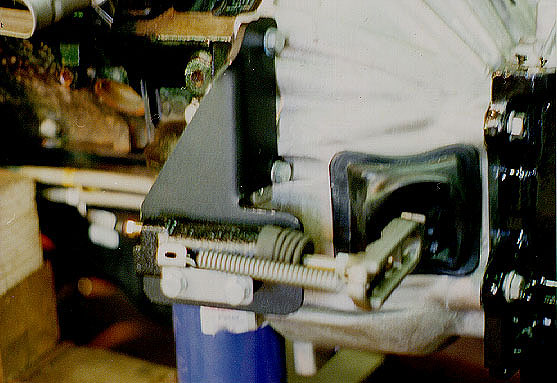

 The
NV4500 transmission requires modification before it can be mated to the
AA adapter assembly. Most, if not all, GM 4WD transmissions obtained
from a salvage yard will include the GM TC adapter housing, 8.125" in length.
Removal of this housing reveals the NV output shaft, overdrive gears and
a large (5"dia., 4" long) harmonic balancer. This balancer must be
removed. The recommended procedure is to purchase a GM SST socket
to remove the retaining nut. After learning of Mr. Goodwrench's price
for this special socket, I made one myself. Unfortunately, even with
my very heavy-duty socket and an enormous air impact wrench, I could not
budge the retaining nut. After hours of work wasted in building the
SST, I ended up taking 15 minutes and drilled two 1/4" diameter holes on
opposing sides of the nut and broke it with a chisel. This is definitely
the easiest way to remove this balancer. The photo to the left shows
the NV4500 with the balancer removed. The threads between the two
splined sections of the output shaft are the ones threaded for the balancer-retaining
nut.
The
NV4500 transmission requires modification before it can be mated to the
AA adapter assembly. Most, if not all, GM 4WD transmissions obtained
from a salvage yard will include the GM TC adapter housing, 8.125" in length.
Removal of this housing reveals the NV output shaft, overdrive gears and
a large (5"dia., 4" long) harmonic balancer. This balancer must be
removed. The recommended procedure is to purchase a GM SST socket
to remove the retaining nut. After learning of Mr. Goodwrench's price
for this special socket, I made one myself. Unfortunately, even with
my very heavy-duty socket and an enormous air impact wrench, I could not
budge the retaining nut. After hours of work wasted in building the
SST, I ended up taking 15 minutes and drilled two 1/4" diameter holes on
opposing sides of the nut and broke it with a chisel. This is definitely
the easiest way to remove this balancer. The photo to the left shows
the NV4500 with the balancer removed. The threads between the two
splined sections of the output shaft are the ones threaded for the balancer-retaining
nut.
 The
AA approach to mating the NV4500 to the TLC transfer case is accomplished
with a spud shaft that slips over the NV output shaft, extends through
the adapter housing and into the TC, becoming the input shaft for that
gear box. The NV4500 is a very long transmission, and in order to
reduce the total length of the complete assembly, the AA conversion requires
that the NV output shaft be cut off just aft of the foremost splines.
For this procedure, I used the steady hand of my understanding wife to
slowly turn the shaft while I cut with an air-powered cut-off disk.
This photo shows the shaft after being cut at the AA-recommended length
of 4.5" from the rear of the transmission housing. AA also provides
the set collar shown, secured to the shaft with two allen bolts, to hold
the overdrive gears in proper position. The AA spud shaft mates with
the splines on the rear of the shaft in this photo. The gears and
shaft illustrated in this photo are lubricated by the main NV4500 synthetic
oil bath. The NV requires use of special GM or MOPAR
synthetic gear lube, and consequently an anerobic sealer must be used in
mating and sealing all components in contact with the lubricant.
The
AA approach to mating the NV4500 to the TLC transfer case is accomplished
with a spud shaft that slips over the NV output shaft, extends through
the adapter housing and into the TC, becoming the input shaft for that
gear box. The NV4500 is a very long transmission, and in order to
reduce the total length of the complete assembly, the AA conversion requires
that the NV output shaft be cut off just aft of the foremost splines.
For this procedure, I used the steady hand of my understanding wife to
slowly turn the shaft while I cut with an air-powered cut-off disk.
This photo shows the shaft after being cut at the AA-recommended length
of 4.5" from the rear of the transmission housing. AA also provides
the set collar shown, secured to the shaft with two allen bolts, to hold
the overdrive gears in proper position. The AA spud shaft mates with
the splines on the rear of the shaft in this photo. The gears and
shaft illustrated in this photo are lubricated by the main NV4500 synthetic
oil bath. The NV requires use of special GM or MOPAR
synthetic gear lube, and consequently an anerobic sealer must be used in
mating and sealing all components in contact with the lubricant.
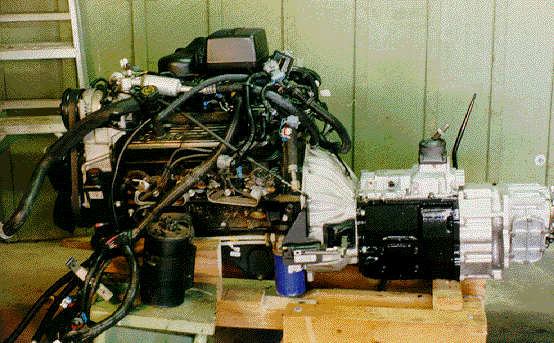
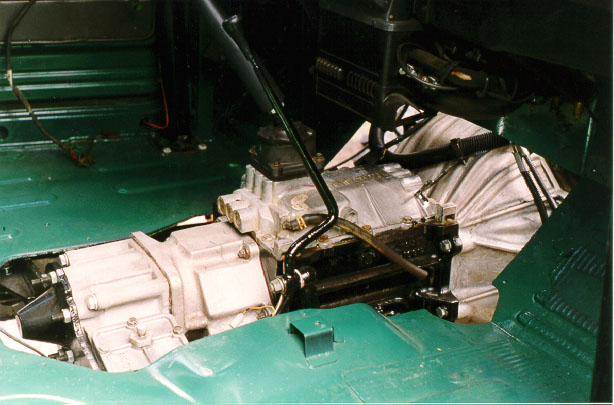
The above photo shows the bellhousing, NV4500, AA adapter and transfer case in their final position in the Cruiser. The NV shift tower sits well behind the heater and with its short throw is ideally located for optimal shifting. Note, however, that the AA transfer-case shift bracket results in the stock TC arm located about 2.5" aft of the NV shifter (and cowl hole). To overcome this mismatch, avoid elongating the TC hole in the cowl, and provide a longer TC shift lever, we fabricated a new and longer shift lever that includes a bent extension moving the lever forward.
Breather ports for the NV and transfer case have been plumbed into a 0.5" rubber line running to the top of the engine bay where they mate with similar lines from the two differential housings in a KNC breather filter assembly.
Finally, the photo below shows a view of the rear view of the NV assembly.

Cruise
Home For Additional Conversions and Features
|
Want info on how to JOIN this ring?? |
| [Prev] [Skip Next] [Random] [List Sites] [Next] |